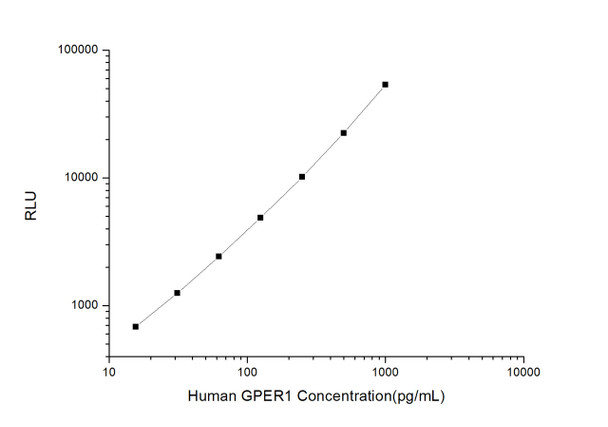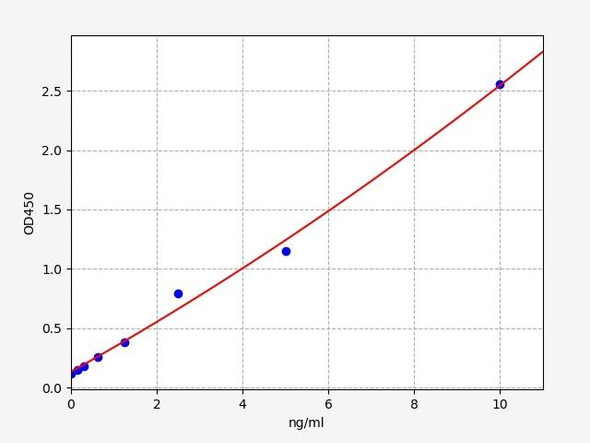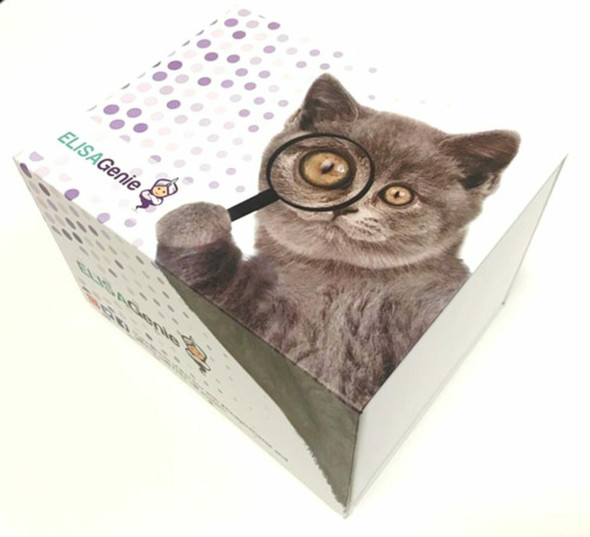Human Cell Death ELISA Kits
Human GPER1 (G Protein Coupled Estrogen Receptor 1) CLIA Kit (HUES00671)
- SKU:
- HUES00671
- Product Type:
- ELISA Kit
- ELISA Type:
- CLIA Kit
- Size:
- 96 Assays
- Sensitivity:
- 9.38pg/mL
- Range:
- 15.63-1000pg/mL
- ELISA Type:
- Sandwich
- Reactivity:
- Human
- Sample Type:
- Serum, plasma and other biological fluids
- Research Area:
- Cell Death
Description
| Assay type: | Sandwich |
| Format: | 96T |
| Assay time: | 4.5h |
| Reactivity: | Human |
| Detection method: | Chemiluminescence |
| Detection range: | 15.63-1000 pg/mL |
| Sensitivity: | 9.38 pg/mL |
| Sample volume: | 100µL |
| Sample type: | Serum, plasma and other biological fluids |
| Repeatability: | CV < 15% |
| Specificity: | This kit recognizes Human GPER1 in samples. No significant cross-reactivity or interference between Human GPER1 and analogues was observed. |
This kit uses Sandwich-CLIA as the method. The micro CLIA plate provided in this kit has been pre-coated with an antibody specific to Human GPER1. Standards or samples are added to the appropriate micro CLIA plate wells and combined with the specific antibody. Then a biotinylated detection antibody specific for Human GPER1 and Avidin-Horseradish Peroxidase (HRP) conjugate are added to each micro plate well successively and incubated. Free components are washed away. The substrate solution is added to each well. Only those wells that contain Human GPER1, biotinylated detection antibody and Avidin-HRP conjugate will appear fluorescence. The Relative light unit (RLU) value is measured spectrophotometrically by the Chemiluminescence immunoassay analyzer. The RLU value is positively associated with the concentration of Human GPER1. The concentration of Human GPER1 in the samples can be calculated by comparing the RLU of the samples to the standard curve.
| UniProt Protein Function: | GPER1: Receptor for estrogen. Belongs to the G-protein coupled receptor 1 family. |
| UniProt Protein Details: | Protein type:Membrane protein, integral; Motility/polarity/chemotaxis; Membrane protein, multi-pass; Receptor, GPCR; GPCR, family 1 Chromosomal Location of Human Ortholog: 7p22. 3 Cellular Component: Golgi apparatus; integral to plasma membrane; early endosome; dendrite; nuclear envelope; trans-Golgi network; recycling endosome; perinuclear region of cytoplasm; cytoplasm; keratin filament; intracellular; dendritic shaft; endoplasmic reticulum membrane; cytoplasmic vesicle membrane; endoplasmic reticulum; postsynaptic density; Golgi membrane; presynaptic membrane; axon; mitochondrial membrane; presynaptic active zone; plasma membrane; nerve terminal; nucleus; cell junction Molecular Function:G-protein coupled receptor activity; protein binding; estrogen receptor activity; chromatin binding; mineralocorticoid receptor activity; steroid binding Biological Process: positive regulation of apoptosis; generation of action potential; positive regulation of caspase activity; nuclear fragmentation during apoptosis; negative regulation of DNA metabolic process; positive regulation of vasodilation; positive regulation of neurotransmitter secretion; negative regulation of leukocyte activation; negative regulation of cell proliferation; elevation of cytosolic calcium ion concentration; positive regulation of MAPKKK cascade; positive regulation of epidermal growth factor receptor signaling pathway; positive regulation of cAMP biosynthetic process; positive regulation of cell proliferation; inflammatory response; steroid hormone receptor signaling pathway; positive regulation of neurogenesis; cytosolic calcium ion homeostasis; negative regulation of lipid biosynthetic process; positive regulation of insulin secretion; positive regulation of inositol trisphosphate biosynthetic process; cell cycle; negative regulation of fat cell differentiation; apoptotic chromosome condensation; positive regulation of phosphoinositide 3-kinase cascade; G-protein coupled receptor protein signaling pathway; mineralocorticoid receptor signaling pathway; negative regulation of inflammatory response; positive regulation of G-protein coupled receptor protein signaling pathway; innate immune response; positive regulation of transcription from RNA polymerase II promoter; steroid hormone mediated signaling; positive regulation of protein amino acid phosphorylation; positive regulation of release of sequestered calcium ion into cytosol; positive regulation of cell migration |
| NCBI Summary: | This gene is a member of the G-protein coupled receptor 1 family and encodes a multi-pass membrane protein that localizes to the endoplasmic reticulum. The protein binds estrogen, resulting in intracellular calcium mobilization and synthesis of phosphatidylinositol 3,4,5-trisphosphate in the nucleus. This protein therefore plays a role in the rapid nongenomic signaling events widely observed following stimulation of cells and tissues with estrogen. Alternate transcriptional splice variants which encode the same protein have been characterized. [provided by RefSeq, Jul 2008] |
| UniProt Code: | Q99527 |
| NCBI GenInfo Identifier: | 3023539 |
| NCBI Gene ID: | 2852 |
| NCBI Accession: | Q99527. 1 |
| UniProt Secondary Accession: | Q99527,Q8BMP4, O08878, |
| UniProt Related Accession: | Q99527 |
| Molecular Weight: | 42,248 Da |
| NCBI Full Name: | G-protein coupled estrogen receptor 1 |
| NCBI Synonym Full Names: | G protein-coupled estrogen receptor 1 |
| NCBI Official Symbol: | GPER1 |
| NCBI Official Synonym Symbols: | mER; CEPR; GPER; DRY12; FEG-1; GPR30; LERGU; LyGPR; CMKRL2; LERGU2; GPCR-Br |
| NCBI Protein Information: | G-protein coupled estrogen receptor 1; heptahelix receptor; chemokine receptor-like 2; IL8-related receptor DRY12; membrane estrogen receptor; G protein-coupled receptor 30; chemoattractant receptor-like 2; leucine rich protein in GPR30 3'UTR; lymphocyte- |
| UniProt Protein Name: | G-protein coupled estrogen receptor 1 |
| UniProt Synonym Protein Names: | Chemoattractant receptor-like 2; Flow-induced endothelial G-protein coupled receptor 1; FEG-1; G protein-coupled estrogen receptor 1; G-protein coupled receptor 30; GPCR-Br; IL8-related receptor DRY12; Lymphocyte-derived G-protein coupled receptor; LYGPR; Membrane estrogen receptor; mER |
| UniProt Gene Name: | GPER1 |
| UniProt Entry Name: | GPER1_HUMAN |
As the RLU values of the standard curve may vary according to the conditions of the actual assay performance (e. g. operator, pipetting technique, washing technique or temperature effects), the operator should establish a standard curve for each test. Typical standard curve and data is provided below for reference only.
| Concentration (pg/mL) | RLU | Average | Corrected |
| 1000 | 50105 57245 | 53675 | 53650 |
| 500 | 20995 23983 | 22489 | 22464 |
| 250 | 10349 10073 | 10211 | 10186 |
| 125 | 4743 5059 | 4901 | 4876 |
| 62.5 | 2562 2344 | 2453 | 2428 |
| 31.25 | 1354 1208 | 1281 | 1256 |
| 15.63 | 673 743 | 708 | 683 |
| 0 | 24 26 | 25 | -- |
Precision
Intra-assay Precision (Precision within an assay): 3 samples with low, mid range and high level Human GPER1 were tested 20 times on one plate, respectively.
Inter-assay Precision (Precision between assays): 3 samples with low, mid range and high level Human GPER1 were tested on 3 different plates, 20 replicates in each plate.
| Intra-assay Precision | Inter-assay Precision | |||||
| Sample | 1 | 2 | 3 | 1 | 2 | 3 |
| n | 20 | 20 | 20 | 20 | 20 | 20 |
| Mean (pg/mL) | 50.50 | 142.42 | 482.38 | 51.19 | 143.59 | 501.52 |
| Standard deviation | 5.04 | 13.09 | 48.14 | 5.14 | 16.69 | 30.09 |
| C V (%) | 9.98 | 9.19 | 9.98 | 10.04 | 11.62 | 6.00 |
Recovery
The recovery of Human GPER1 spiked at three different levels in samples throughout the range of the assay was evaluated in various matrices.
| Sample Type | Range (%) | Average Recovery (%) |
| Serum (n=5) | 89-99 | 94 |
| EDTA plasma (n=5) | 90-103 | 97 |
| Cell culture media (n=5) | 86-98 | 93 |
Linearity
Samples were spiked with high concentrations of Human GPER1 and diluted with Reference Standard & Sample Diluent to produce samples with values within the range of the assay.
| Serum (n=5) | EDTA plasma (n=5) | Cell culture media (n=5) | ||
| 1:2 | Range (%) | 96-107 | 92-108 | 101-114 |
| Average (%) | 102 | 99 | 107 | |
| 1:4 | Range (%) | 92-105 | 104-116 | 86-96 |
| Average (%) | 98 | 110 | 91 | |
| 1:8 | Range (%) | 93-109 | 103-115 | 86-99 |
| Average (%) | 100 | 109 | 93 | |
| 1:16 | Range (%) | 101-116 | 89-100 | 89-101 |
| Average (%) | 107 | 95 | 94 |
An unopened kit can be stored at 4°C for 1 month. If the kit is not used within 1 month, store the items separately according to the following conditions once the kit is received.
| Item | Specifications | Storage |
| Micro CLIA Plate(Dismountable) | 8 wells ×12 strips | -20°C, 6 months |
| Reference Standard | 2 vials | |
| Concentrated Biotinylated Detection Ab (100×) | 1 vial, 120 µL | |
| Concentrated HRP Conjugate (100×) | 1 vial, 120 µL | -20°C(shading light), 6 months |
| Reference Standard & Sample Diluent | 1 vial, 20 mL | 4°C, 6 months |
| Biotinylated Detection Ab Diluent | 1 vial, 14 mL | |
| HRP Conjugate Diluent | 1 vial, 14 mL | |
| Concentrated Wash Buffer (25×) | 1 vial, 30 mL | |
| Substrate Reagent A | 1 vial, 5 mL | 4°C (shading light) |
| Substrate Reagent B | 1 vial, 5 mL | 4°C (shading light) |
| Plate Sealer | 5 pieces | |
| Product Description | 1 copy | |
| Certificate of Analysis | 1 copy |
- Set standard, test sample and control (zero) wells on the pre-coated plate and record theirpositions. It is recommended to measure each standard and sample in duplicate. Note: addall solutions to the bottom of the plate wells while avoiding contact with the well walls. Ensuresolutions do not foam when adding to the wells.
- Aliquot 100µl of standard solutions into the standard wells.
- Add 100µl of Sample / Standard dilution buffer into the control (zero) well.
- Add 100µl of properly diluted sample (serum, plasma, tissue homogenates and otherbiological fluids. ) into test sample wells.
- Cover the plate with the sealer provided in the kit and incubate for 90 min at 37°C.
- Aspirate the liquid from each well, do not wash. Immediately add 100µL of BiotinylatedDetection Ab working solution to each well. Cover the plate with a plate seal and gently mix. Incubate for 1 hour at 37°C.
- Aspirate or decant the solution from the plate and add 350µL of wash buffer to each welland incubate for 1-2 minutes at room temperature. Aspirate the solution from each well andclap the plate on absorbent filter paper to dry. Repeat this process 3 times. Note: a microplatewasher can be used in this step and other wash steps.
- Add 100µL of HRP Conjugate working solution to each well. Cover with a plate seal andincubate for 30 min at 37°C.
- Aspirate or decant the solution from each well. Repeat the wash process for five times asconducted in step 7.
- Add 100µL of Substrate mixture solution to each well. Cover with a new plate seal andincubate for no more than 5 min at 37°C. Protect the plate from light.
- Determine the RLU value of each well immediately.






